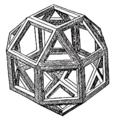Body model
A body model is a physical model of a geometric body . While a geometric body describes the idealized, mathematical form of a real object, a body model, conversely, represents a physical realization (“representative”) of the mathematical term. Body models aim at the haptic experience of the mathematical body in order to develop spatial imagination . In contrast, software applications for dynamic spatial geometry , which are increasingly used in teaching instead of physical body models, focus solely on the visual sensory channel (however, they also allow the proportions of the body to be interactively and dynamically changed and calculations to be carried out on the virtually constructed bodies ).
Purpose of body models
Body models are used to train spatial imagination and in particular
- To illustrate terms like corner , edge, surface ;
- to visually support the determination of the number of corners, the number of edges, a solid angle or corner degree as well as
- to better understand the spatial position of the room diagonal or body height or to examine the geometry of cut surfaces.
Different types of body models
There are solid bodies, edge models or surface models.
Full body models
Mathematical institutes at universities often have an extensive collection of full-body models for teaching purposes, which were often made by employees. As material find u. a. Wood, metal, glass, cardboard and paper used, later also plastic.
There are surprisingly stable braided models for numerous polyhedra ; They are made from (mostly colored) strips of paper by folding and braiding without using glue .
With the help of rapid prototyping technology and 3D printers , you can now automatically produce complex full-body models yourself in a few hours or days.
The height of the tetrahedron
Parabola as a conic section
Paper model of a pentagon hexacontahedron , 25.4 l volume
Model of a Menger sponge (made of cardboard)
3D printing of the Sierpinski pyramid made of polyamide
Edge models
Edge models can easily be made by yourself, e.g. B. with the help of shish kebab skewers (or toothpicks, drinking straws, pipe cleaners, metal wire, ...) and modeling clay or wax - or with the help of clickies, Polydron or with a zometool. Edge models made of colored lacquered metal rods are also sold for teaching purposes.
Edge model of a polyhedron , drawn by Leonardo da Vinci
Truncated icosahedron (or football polyhedron) made of cherry wood
Edge models not only make it easier to count the edges of the body, they also serve in particular to prepare the drawing of the body (especially the oblique image ).
Surface models
A model from the net of the body can be folded up particularly easily ; for this purpose, the net is supplemented with slots and tabs or adhesive edges. A body model folded from the body network serves in particular to illustrate the procedure for calculating the area of the surface of the body.
Pop-up models are designed so that they can be opened and closed again.
Thread models
In the case of ruled surfaces , thread models can be used to illustrate the (surface) surface.
Thread model of a hyperboloid
See also
literature
- HM Cundy and AP Rollett: Mathematical Models . Oxford University Press, London, 1952 (3rd edition Tarquin Publications, 1981)
- Birgit Brandl: Manufacture of models for spatial geometry lessons . Workshop at the 12th Bayreuth workshop on the 12th Bayreuth mathematics weekend, October 15, 2010, University of Augsburg
- Gustav Adolf Lörcher, Horst Rümmele: Quick models . In: Der Mathematikunterricht (3) 45, 1999, pp. 19–31
- Heinrich Wölpert: Materials for developing spatial concepts in mathematics lessons . In: Der Mathematikunterricht 6, 1983, pp. 7–42
Web links
- GÖTTINGER COLLECTION of mathematical models and instruments - polyhedra , Georg-August-Universität Göttingen
- Treasures - Historical collection of mathematical models of the Institute of Mathematics . Exhibition catalog, Martin Luther University Halle-Wittenberg, 2008
Individual evidence
- ↑ Geometry: Body , in: Duden Mathematik 4, Comments on the Chapters, p. 53
- ↑ Secure knowledge and skills, geometry in space, secondary . State Institute for Schools and Education Mecklenburg-Western Pomerania, Schwerin, 2005
- ↑ UNIVERSITY COLLECTIONS IN GERMANY
- ↑ Polyhedron made of braided strips (Hans-Bernhard Meyer)
- ↑ Weaving bodies (mathematical handicrafts, Jürgen Köller)
- ↑ Modular Origami Diagrams (Origami Resource Center)
- ↑ George W. Hart's Rapid Prototyping Web Page
- ↑ George W. Hart: Creating a Mathematical Museum on Your Desk. Mathematical Intelligencer 27 (4), 2005
- ↑ Rüdiger Vernay: Working with Klickies - suggestions, task cards and comments . MUED, Nottuln-Appelhülsen, 2008
- ↑ Polydron - Mathematikum, casting
- ↑ George W. Hart and Henri Picciotto: Zome Geometry - Hands-on Learning with Zome Models . Key Curriculum Press, 2001
- ↑ Body-edge models ( Memento of the original from April 29, 2014 in the Internet Archive ) Info: The archive link was inserted automatically and has not yet been checked. Please check the original and archive link according to the instructions and then remove this notice. of the company Wiemann Lehrmittel (M. Zirbes)
- ↑ Hans J. Schmidt: Prof. Dr. Brian Teaser's body calculation (with handicraft instructions for pop-up models) . Aulis Verlag, 3rd unchanged edition 2008
- ↑ Handicraft sheets (nets with adhesive edges) for Platonic solids and Archimedean solids (Reimund Albers, University of Bremen)
- ^ Walser, Hans: Dynamic spatial geometry: pop-up polyhedra and screw polyhedra. In: Der Mathematikunterricht 3, 1999, pp. 64–74
- ↑ Pop-up models ( page no longer available , search in web archives ) Info: The link was automatically marked as defective. Please check the link according to the instructions and then remove this notice. . Mathematik lehren 54, 1992, pp. 32-33




















